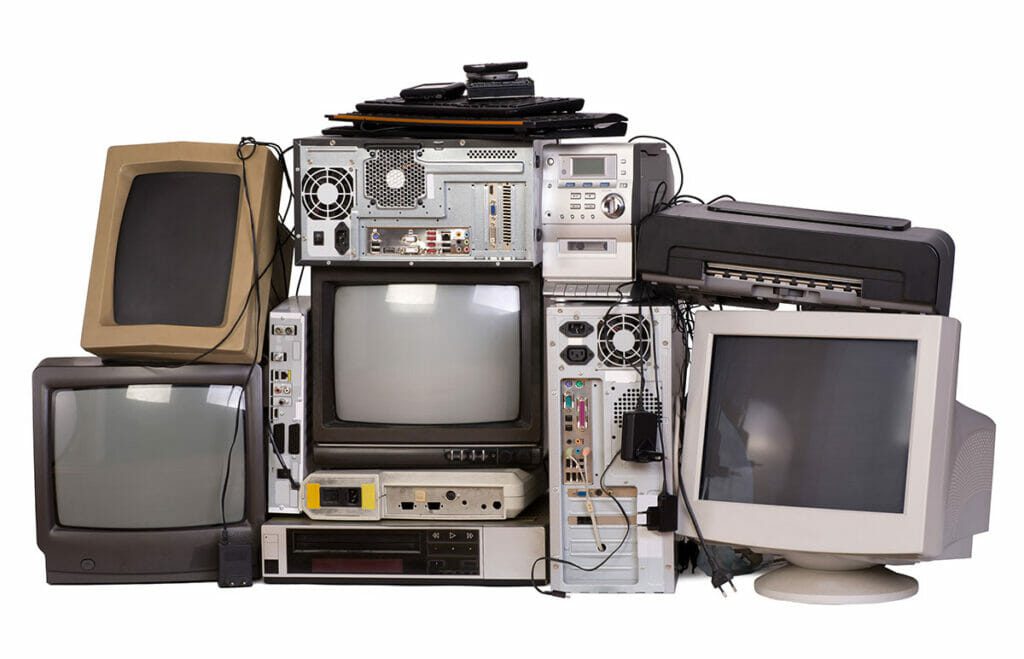What is e-Waste?

We use many electronic devices at home and work now. However, improper disposal can lead to serious problems. Hazardous waste can harm people’s health and the Environment. In this session, we will look at electronic waste, discuss its effects, and discuss how e-recycling can help fix these problems.
Key Highlights
- E-waste is made up of old electronic products we throw away. This can be harmful to our health and the Environment.
- We are using more electronic devices quickly. This adds to the e-waste problem.
- Toxic materials, like heavy metals in e-waste, can leak into the Environment, harming people and nature.
- Recycling electronic waste reduces pollution. It also lowers the need for new resources from the Earth.
- Skilled recyclers ensure that they manage dangerous materials safely and responsibly.
- We need to follow the rules for e-waste and support safe disposal. These steps are essential for a sustainable future.
The rise in e-waste generation
The rise in consumer electronics is a significant cause of growing e-waste. Technology improves quickly, making electronic devices old quickly. Excitement for new gadgets leads to shorter lifespans for these devices. New electronics mean many old devices get tossed out, worsening the e-waste problem.

Due to the rapid growth of technology, there are concerns about e-waste and its health effects. E-waste includes old devices with toxic materials, including lead, mercury, and cadmium. These materials can pollute groundwater. If not managed well, they can harm the Environment and lead to pollution. Because of these dangers, California has rules about how to handle e-waste. It is essential to find a professional e-waste removal service close to me.
The UN states that the world produces over 50 million tons of e-waste annually. A common practice involves disguising US waste as gifts and sending it abroad. These shipments often end up in Africa and China, which is regrettable. People do not pay much attention to the pollution and damage it causes to the local community.
Many electronic devices contain heavy metals like lead, mercury, and cadmium. Disposing of these devices in landfills can release toxins, harming the soil, water, ecosystems, and human health.
Throwing away e-waste by burning it is harmful. It releases bad pollution and greenhouse gas emissions into the air. These emissions make climate change worse. This shows how important it is to fix the e-waste problem.
Types of electronic devices contributing to e-waste
Many electronic devices create more e-waste. Mobile phones play a significant role in this problem. They often break down quickly, and people want the latest models. Millions of phones are thrown away each year, making e-waste even worse.
Large appliances, like fridges, washers, and ACs, cause huge problems with e-waste. These appliances contain hazardous materials and refrigerants, so we must handle and dispose of them carefully.
Complex parts like circuit boards in computers and TVs increase the toxicity of e-waste. These boards often contain precious metals and harmful substances. Careful recycling and removal of these materials are essential to protecting the Environment.
Toxic Components and Environmental Threats
Electronic waste is often seen as a “hidden danger.” It contains harmful materials that can harm people and the Environment. Lead is a strong neurotoxin. It is found in circuit boards, batteries, and cathode ray tubes. Mercury is another harmful heavy metal. It is often found in older displays and fluorescent lamps.
Being near these harmful materials can cause health issues. The WHO warns of risks to child development, kidney damage, and breathing problems. Throwing away e-waste the wrong way can release toxins into the Environment. These toxins can pollute water sources and enter the food chain.
E-waste often contains brominated flame retardants (BFRs), which are added to plastics to help prevent fires. Sadly, BFRs can interrupt how hormones function, affecting growth, reproduction, and metabolism. It’s essential to be aware of these risks in e-waste. Understanding them helps you manage, recycle, and safely dispose of e-waste, protecting both human health and the Environment.
Impact of Improper e-waste Disposal on the Environment
Throwing away e-waste like cell phones, circuit boards, and hard drives can cause problems. When these devices are dumped in landfills, they breathe toxicity into our planet. As they decay, harmful chemicals leak into the Earth and water, creating a mix of pollution. Let’s rethink our tech trash before it adds to our environmental woes. Pollution can harm local ecosystems and threaten water quality. It also creates significant issues for wildlife and people who rely on these water sources.
Many developing countries burn e-waste. This practice releases harmful substances into the air, adding to air pollution. It can harm health, especially for those with breathing problems. Burning e-waste releases dioxins, furans, and heavy metals, harming the health of people nearby.
Improperly handling e-waste perpetuates pollution, making it challenging to protect the Environment. Strict rules, safe recycling, and public education are essential. These steps lower the harm e-waste disposal does to our health and the Environment.
E-Waste Management in the United States
The United States is focusing more on the issues caused by electronic waste. Both the federal and state governments are trying to improve e-waste recycling. Federal laws address e-waste, but many states have stricter rules to manage this growing issue. As e-waste grows and harmful materials rise in devices, more laws appear. These laws are to reduce health and environmental risks from e-waste.
Current legislation and regulations on e-waste
The Electronic Waste Recycling Act was passed at the federal level in 2003. It sets rules for handling e-waste from old electronics, worsening the problem.
Technology is expanding fast, which raises worries about e-waste and its health effects. E-waste is old devices with harmful materials like lead, mercury, and cadmium. If we don’t manage them right, these materials can pollute groundwater. Because of these risks, California has laws about dealing with e-waste. It is crucial to find a good e-waste removal service nearby.
The UN says the world makes over 50 million tons of e-waste annually. A common practice is to hide US waste as gifts and send it to other countries. These shipments usually go to Africa and China, which is unfortunate. Many people do not notice the pollution and harm it brings to the local community.
Many electronic devices contain heavy metals like lead, mercury, and cadmium. Throwing these devices in landfills can leak harmful toxins, which can enter the soil and water and harm ecosystems and human health.
Burning e-waste is harmful. It releases toxic pollution and greenhouse gases into the air. These gases worsen climate change. This highlights the need to solve the e-waste issue.
Impact of Poor e-waste Disposal on the Environment
Improperly throwing away e-waste is terrible for the Environment. E-waste in landfills can leak harmful chemicals into the soil and water. Pollution can harm local ecosystems and reduce water quality. This creates significant issues for wildlife and people who rely on these water sources.
Many developing countries burn e-waste. This practice releases harmful substances into the air, adding to air pollution. It can harm health, especially for people with breathing issues. Burning e-waste releases dioxins, furans, and heavy metals, which can harm the health of nearby residents.
Neglecting e-waste management leads to pollution that endangers our Environment. Enforcing strict regulations and implementing safe recycling methods are essential. Equally important is raising awareness about this pressing issue. These steps are key to reducing health risks and environmental hazards from e-waste disposal.
Role of professional e-waste removal services
Certified electronics recyclers are essential for handling electronic waste. These companies recycle e-waste safely. They agencies. It helps recycle electronic waste safely. This includes computers, printers, and monitors from federal offices. The act also promotes good disposal practices.
Many states have established their own rules for electronic waste.
California is a leader in this area. In 2003, California sparked a revolution with the Electronic Waste Recycling Act. This groundbreaking law built a framework for managing e-waste throughout the state. At its heart lies a recycling program funded by a small fee for new electronics. This critical law makes other states look to California for new e-waste solutions.
These rules help us manage e-waste safely. They lower risks to human health and the Environment.
Benefits of E-Recycling
E-recycling sparks a dual revolution, benefiting the Environment and the economy. Recycling old electronics helps us do more than throw away waste. It supports a greener future, a win-win for our planet, and a path to sustainable progress. Let’s transform yesterday’s gadgets into tomorrow’s treasures, one device at a time.
E-recycling boosts a circular economy. It saves resources, cuts pollution, and helps manage electronic waste better. We all need to start e-recycling. It’s essential for protecting our planet for future generations.
Reducing environmental pollution through e-recycling
One significant benefit of e-recycling is that it helps reduce pollution. E-waste in landfills and incinerators pollutes the right skills, tools, and certifications. They follow strict safety and environmental rules. This helps to manage hazardous materials correctly.
Using e-waste removal services is good for the future. They keep e-waste out of landfills and help with recycling. These services let you safely get rid of electronic devices, including computers, hard drives, phones, batteries, and other accessories.
The electronic recycling industry is vital. It uses valuable materials from e-waste, helping to create a circular economy. It also reuses metals and resources to make new products.
Lowering pollution by recycling electronics.
One significant advantage of e-recycling is that it helps cut down pollution. E-waste in landfills and burning sites harm our air, water, and soil. We need to keep it away. These harmful substances can be destructive to human health.
Recycling e-waste cuts down the need for new materials taken from the Earth. Mining can cause much pollution. When we use recycled materials from e-waste, we save our resources and lessen the harm from mining.
E-recycling also helps reduce greenhouse gas emissions from producing new electronics. It takes less energy to recycle old materials than to make new ones. This practice helps lower emissions and supports our fight against climate change.
Promoting sustainable use of resources
E-recycling is essential for using our natural resources smartly. Many electronic devices have valuable metals like gold, silver, copper, and palladium. When we recycle these metals, we can reuse them. This practice lowers the need to take new resources from the Earth. As a result, it also helps the Environment by reducing the harm done by mining.
E-recycling helps us build a circular economy. This means we keep using resources for as long as possible. We get valuable materials from old electronics, reducing the need for new resources. It also helps us make materials last longer and lowers waste.
Recycling e-waste saves resources and helps us use what we have. It also reduces the use of outside materials and supports local supply chains. This practice also boosts the economy and protects the Environment.
Conclusion
E-recycling is essential to reducing the harm caused by electronic waste. As e-waste grows, we must know the risks of throwing it away, which can harm the Environment. Effective waste management and e-recycling cut pollution and help us use resources wisely. Laws and expert services are essential for proper e-waste disposal. Remember, each person can make a change by throwing away e-waste items the right way. Together, we can keep our planet safe for the future.
